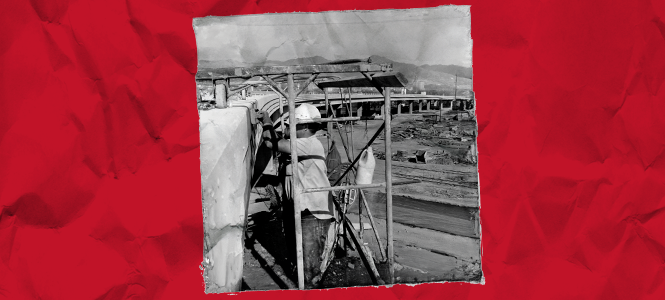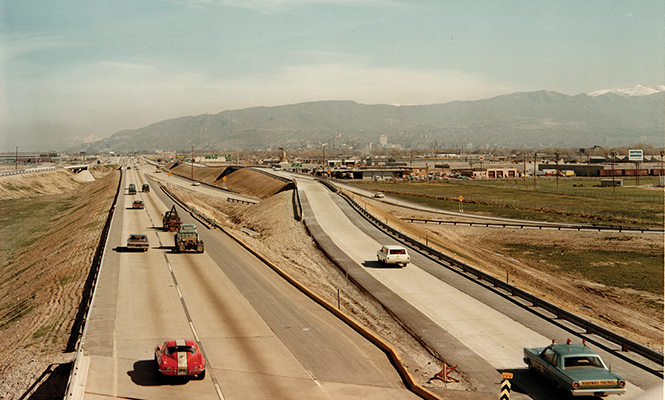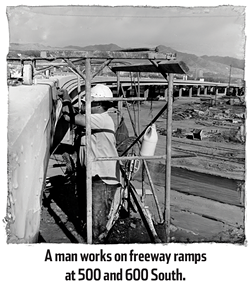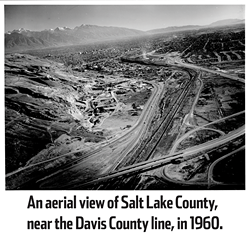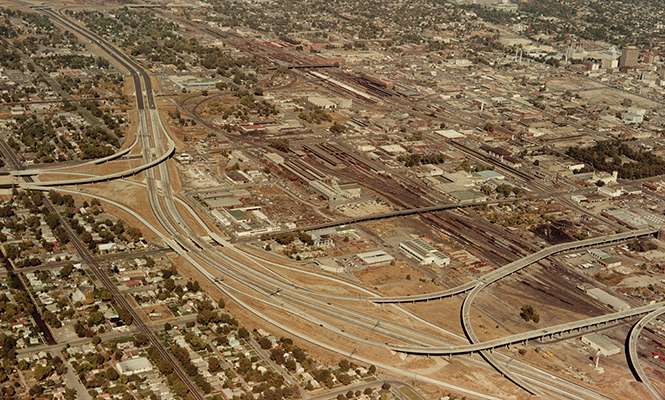UDOT's plans to expand I-15 through the west side echo the fights over its initial construction
On the Road Again
By Tameron FawcettIn July 1946, the Utah State Road Commission called for a meeting between themselves, the U.S. Bureau of Public Roads and members of the Salt Lake City and County Commissions to ensure cooperation on a new transportation "master plan."
At the time, State Street (Highway 89) served as the main artery for the city's automotive traffic. And conditions were becoming uncomfortable, with commercial drivers rattling freight through downtown alongside commuter cars.
City, state and federal officials were beginning to explore whether a new kind of road, an express highway free of intersections and foot traffic, could move the heavy trucks and longer-distance traffic out of the heart of the city.
The four-lane highway running north to south that they conceived would ultimately reshape how Utahns get around, with profound ripple effects on state transportation, land use and housing policy. Residents know the project now as Interstate 15, but in 1946, the freeway still had a long road ahead of its construction.
Back then—as it is again today—a conflict was brewing over "right-of-way," or the land area through which the road is built. Only in July 1946, the state hadn't yet acquired land for an obvious route, but participants at that July meeting left it with a general agreement that the new express highway should be built through Salt Lake City's west side.
"For the sake of continued progress in the city, this highway should be constructed as soon as possible," state Roads Commissioner David A. Affleck said at the time. "If it is found necessary to remove some houses in order to lay out the site, I think it should be done."
To those who lived in west-side neighborhoods, the highway threatened their homes, businesses and community. And while opponents ultimately failed to prevent the highway's construction, time and hindsight have proven them correct in many of their dire predictions for the areas immediately adjacent to the right-of-way.
In the lead-up to the freeway's initial construction, The Salt Lake Telegram wrote in support of the west side and its residents. "The people who live on the west side have a right to say what shall be done to the area in which they live. They have a right to protest any project which threatens to ruin their homes. They have a right to say where this expressway shall be built on the west side. Any such highway, if it is built, must be an asset and not a liability to the people most immediately affected."
Today, the Utah Department of Transportation (UDOT) has commited to expanding I-15 between Salt Lake City and Farmington. With cost estimates for the project having ballooned to upwards of $4 billion, Utahns are poised to repeat the first fights over this stretch of roadway.
A Rising Community
The west-side communities' roots run as far back in time as the city of Salt Lake itself, when early Latter-Day Saints built Pioneer Fort to weather their first winter at what is now Pioneer Park. From the west side grew the city of Salt Lake and by the 1870s, the railroad had opened a path for migrants into the city.
Together, these travelers built the west side up around the railroad as a diverse community. The area was deeply mixed use, with commercial areas intermingled with residences along the railway and further west into farmland. Through the years, the railway brought a boom in industry across the city, but especially within the west-side neighborhoods. Home to "Little Italy," "Greek Town," "Swede Town"—or for some, "poor town"—the west side fostered these communities and many more.
The challenges the west side faced at the turn of the 20th century were not dissimilar to those the rest of the city faced. But progressive reforms were uneven across the city. Wastewater flowed in canals, and the dirt roads were difficult to travel in rain.
Economic conditions did not favor the west side, making it difficult for the area to develop on vital needs like the east side could. Prejudicial red-lining further devalued the area and marked it as hazardous to development. This economic disadvantage snowballed as people who could afford to move to more affluent areas did so, leaving the area financially worse off.
But for the residents of the west side who remained, as well as newcomers, there was a deeply held value in this area of the city. As reforms spread, the west side saw improved housing conditions with the construction of new developments at a rapid clip before and after World War II.
Although city services and facilities lagged behind, the west side was on the rise, as noted by a newspaper columnist writing for the Salt Lake Telegram. "Salt Lake City can well be proud of the west side and its development. Go out and see if you are not familiar with what has been happening there. You'll be surprised, and you'll join with the Telegram in saying to west siders: Bravo!"
The Freeway Revolt
"Somebody's going to get hurt in this business," said west-side resident Jacob Westbrook during the first mass meeting of west siders in December 1947, shortly after the first highway route options were made public. Anxieties were centered on the destruction of housing and schools and the expected creation of a "blighted area between the railroad tracks and wherever the highway [would be] built."
Advocates won early victories when then-Gov. Herbert B. Maw appointed Rep. Nellie Jack to lead a committee to advise on the highway. Jack, a lifelong west-side resident, took a firm stance against the construction of the highway. "We are definitely opposed to any construction project which will demolish homes, schools and other civic gains made on the west side," Jack said at one committee meeting.
Maw himself promised west-side residents he would not sign off on any route that would "slice through the center of any residential property." As a response to this criticism, Roads Commission Chairman Ray H. Leavitt pushed the city to survey its own route and submit it to the state. But city officials balked at the notion that they would make the state's engineering and construction decisions.
"The commission was not discriminating in any manner against any residential group," Leavitt affirmed, "but had suggested the west-side route after careful study based on available funds and minimum costs."
While the city did explore its own survey, alternative routes entirely west of the city proper or set along 800 East failed to find backing. And the only consensus alternative, set alongside the railway at 400 West, bristled against long term plans of both industrial and highway expansion. The Roads Commission, meanwhile, continued to favor a route along 700 and 800 West.
Ezra Knowlton, a chief engineer for the Road Commission, offered this explanation on the route disagreements: "Utah's capital city is so located, in relation to mountain barriers on the east, unsatisfactory soil conditions and an intricate system of railroads on the west, and the natural entrances to the valley on the north and south, that the most feasible highway location to serve the city proper is restricted by natural controls to a very limited area."
Talks between the city, its residents, and state officials stalled out in the following years, but circumstances were changing. Gov. Maw had been defeated in 1948 and his successor, J. Bracken Lee, had made no promise to protect residential areas on the west side. There was also mountain traffic pressure from other roads projects in the state, which had seen the construction of a four-lane highway from Brigham City to Springville, with a major gap being that of Salt Lake City.
City officials reluctantly agreed to move ahead with a 700 West route in 1951. By then, anticipated costs for what Knowlton considered to be "the most important single road section in the entire 5,000-mile state highway system" had doubled to $20 million.
Disagreements over the final route offered an obvious explanation for the recurring delays, but were misleading.
Herb Price, writing for The Salt Lake Telegram, offered this distillation of the debate: "The ultimate question in construction of the proposed west-side expressway—as in other such projects—revolves around one vital word: M-O-N-E-Y."
When the city had OK'd the west-side route, they agreed to a cost-sharing arrangement. That agreement suddenly dissolved in 1953, although the city had continued to bar any new developments along the proposed right-of-way.
For the following two years, the state made no progress on land acquisition and in April 1955, the Roads Commission announced their intention to abandon the route altogether.
The decision was termed a "bombshell" by chief engineer Knowlton, taking all by surprise.
Gov. Lee involved himself in an effort to protect the route. But when west-side land owners organized, demanding fair compensation for their land or the immediate release of rights to develop, the Roads Commission stood firm that they simply couldn't pay.
At this point, the projected costs of building this stretch of express highway had ballooned to $50 million, which the commission did not have. Land-use restrictions on the route were released in what seemed like a definitive victory for west siders. In actuality, it would be their final win.
The landmark 1956 Federal Highway Act was a promise by the federal government to travelers that they could drive from one side of the nation to the other without ever seeing a stoplight—a promise that brought with it funding.
For the previous decade, Salt Lake's express highway project had been a local one, with local funding difficulties. But the Highway Act brought with it a windfall of government momentum ensuring that the highway—now an interstate freeway—would be built.
Gov. George D. Clyde, elected in 1956, weighed in on the renewed freeway project with understanding.
"Wherever the freeway is located, it will remain there indefinitely," he said, "it would be false economy to curve around every building and perpetuate an inadequate design. ... While we don't want to hurt people, we have to think ahead, to think in terms of 25 to 100 years."
Just two years after state leaders had abandoned the 700 West route in 1957, that was exactly where the freeway was going to be built. And after more than 10 years of organizing against the west-side freeway, within months, the right-of-way was purchased and the area demolished.
In January of 1959, Gov. Clyde took to the wheel of a bulldozer, removing tree stumps at the highway's groundbreaking ceremony. By 1964, cars lined the four-lane highway for a ribbon cutting as Interstate 15 formally opened for public use.
That same year, The Salt Lake Tribune ran a column calling for the removal of "blighted" homes in the west side—"they ought to be razed."
Congestion and Expansion
The subject of expanding Salt Lake City's freeway began in October 1964, just a few months after the roadway's initial construction ended. The Salt Lake Area Transportation Study predicted the system would be overloaded by 1980, and envisioned new highways throughout the valley to expand I-15's reach.
At the time it was merely an idea to think ahead for Utah's transit future. It spoke to a notion that has come to define transportation policy—no road is ever truly completed.
Two decades later, in October 1989, real movement toward expansion hit the press following a meeting of the Business/Government Alliances transportation committee. Alliance chair Lowell M. Durham—then-president and CEO of ZCMI—offered his perspective that "gridlock will be a reality within the next 10 years ... if we're going to double the number of cars, we do not have the roads to handle them."
Durham's policy advice kicked off another 10-year debate over Salt Lake City's freeway. Over the next few years, a $1 billion dollar plan took shape to expand I-15 by four lanes.
Residents were quick to voice their dissatisfaction with the plan. Dale Croxford of Murray saw the plan threatened his home of 42 years and told UDOT officials during a public hearing, "I'm 62, and I haven't got the time to wait around. I'm going to sell and get it over with." His home would go on to be demolished.
Critics of expansion directed their ire at the budget for I-15 not being spent on public transit instead. In the years after the freeway, local bus routes on the privately operated Salt Lake City Lines were swiftly cut as ridership diminished.
H. M. Selander, then manager of the Lines, believed he could rescue the flailing bus service. "Freeways and highways from suburb to city heart have claimed thousands of acres of city space. The process simply cannot keep up," Selander reasoned. "And more freeways have generated increased traffic. Ultimately, the freeways will be strangled with traffic ... there can be only one answer: public transit."
Selander did not save the Lines. After efforts by the Legislature to exempt the service from fuel taxes failed, the Lines dwindled and eventually were sold off. Salt Lake City Lines' demise led to growing calls to allow cities to establish local transit authorities in 1969, a first step toward rebuilding what once had been a vibrant public transit network in the city.
A central point of contention during the 1990s expansion discussion were calls for a light rail system or even a monorail in the city. "Freeway expansion cannot by itself solve Salt Lake County's transportation problems. Mass transit, including light rail, must be part of the solution," wrote one editorial that ran in The Salt Lake Tribune after the Legislature placed a moratorium on light rail plans.
Stoked by fears of congestion during the 2002 Winter Olympics and concerns that travel times by 2013 would be untenable, a sense of urgency surrounded the freeway—urgency that policy makers did not reflect on the light rail plan.
Yet, as costs soared for the freeway plan, the Legislature relented, making light rail a small facet of a $2 billion dollar transportation bill aimed at getting construction underway as quickly as possible.
Even with the inclusion, resentment remained. "The Utah Department of Transportation, the Republican Legislature and the governor deserve all the credit for the disgraceful way they are steamrolling the freeway expansion, all for the glory of the 2002 Olympics," wrote William Evans, a Salt Lake City resident, advocating voters "throw the bums out" come the next election. A year and a half later, a majority of Utahns reelected Gov. Michael Leavitt to a historic third term.
The Next Expansion
In March 2022, UDOT announced their intention to further expand I-15. The department argues that without additional lanes, travel times from Salt Lake City to Farmington will be untenable by 2050. Echoing the past, residents are anxious that expansion will take their homes and adversely impact their communities.
UDOT insists that there are no alternatives to expansion—that more people means more people on the road, which means a need for bigger roads.
"To accommodate the population growth we expect by 2050, we will need to expand all travel options," the department stated in its expansion materials. "Our models account for projected growth, including demand from more people and the additional trips that may be taken by car because there is capacity. We have planned to accommodate some—but not all—of the expected growth in demand for travel on I-15. To fully meet the expected demand for freeway travel, it would require more lanes than UDOT understands the community would like to see."
As part of the Environmental Impact Statement process, an overwhelming majority of Utahns who contributed comments expressed displeasure at the prospect of further expansion of the freeway. Fears over destruction of freeway-adjacent homes, increased congestion after expansion and wasted tax dollars are just a few of the issues raised in the public comment period.
Air and noise pollution have had a disproportionate impact on residents of the west side. And several alternatives were suggested, from burying local rail lines along the Rio Grande Depot (a proposal known as the "Rio Grande Plan"), to the conversion of HOV lanes to express bus lanes, to long term investments in high-speed rail.
UDOT's final Environmental Impact Statement is pending, but in their Alternatives Development and Screening Report, UDOT committed to expansion as a necessary next step for I-15. UDOT has repeatedly outlined their desires to improve safety, better connect communities, strengthen the economy and improve mobility. However, they have also been middling to public concerns that expansion will do more harm than good.
In their 2020 Congestion Report, transit advocacy group Transportation for America (T4America) explored freeway development nationwide. They explained that between 1993 and 2017, the United States added 30,511 new freeway lane-miles of road in the largest 100 urban areas—a 42% increase against the 32% growth in population in those same areas. The added lanes have seen travel delays skyrocket by 144%.
"Unfortunately, we have created a system for making transportation investments that drives us to widen roads by default, the most costly response possible," wrote T4America in their report. "Until we change how we make transportation decisions, throwing more funding at the same old tactics will simply perpetuate the same issues."
Without a doubt, Americans rely on interstates to get where they are going. But organizations like T4America question whether that is because they are truly the best option, or because, in many areas, it is the only option.
It can be difficult to get the public excited about long stretches of asphalt. But transportation policy has profound effects on a city and its people—whether they travel the roads or not.
Tameron Fawcett is a researcher who participated in a recently released digital exhibit at Utah State University, exploring the history of Utah roads and the west side freeway. Find more information about the exhibit at library.usu.edu/news/2023/roadofprogress
More by Tameron Fawcett
Latest in Cover Story
Readers also liked…
-
Forget the family pedigree—Robert F. Kennedy Jr should not be the next president of the United States
Trojan Horse
- Jun 21, 2023
-
Women decry harassment and toxic culture at St. George auto dealership
Men at Work
- Oct 11, 2023


